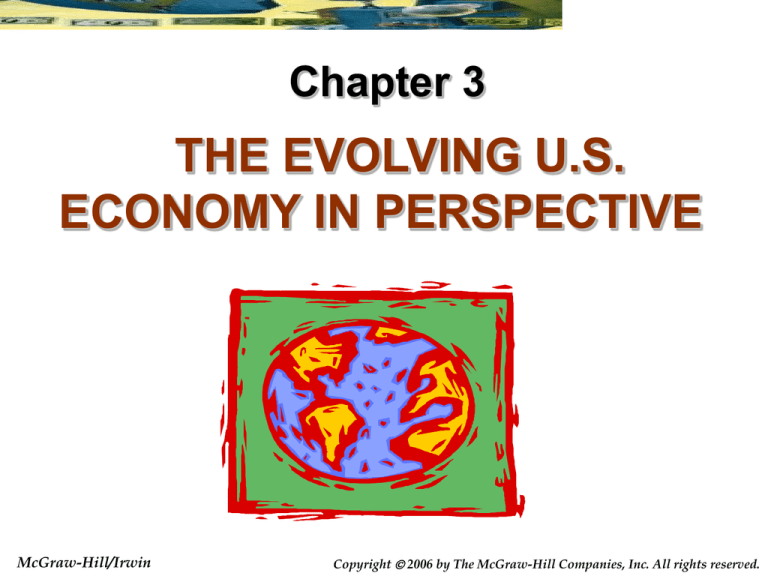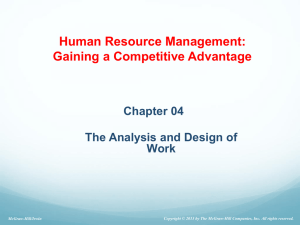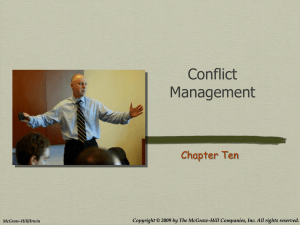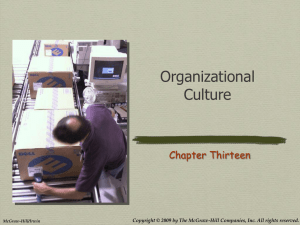
Chapter 3
THE EVOLVING U.S.
ECONOMY IN PERSPECTIVE
McGraw-Hill/Irwin
Copyright 2006 by The McGraw-Hill Companies, Inc. All rights reserved.
3-2
Today’s lecture will:
• Define market economy.
• Compare and contrast socialism with
capitalism
• Describe how businesses, households,
and government interact in a market
economy.
• Summarize the advantages and
disadvantages of various types of
businesses.
McGraw-Hill/Irwin
Copyright 2006 by The McGraw-Hill Companies, Inc. All rights reserved.
3-3
Today’s lecture will:
• Explain why much of the economic
decision making is done by business
and government.
• Distinguish the government’s role as
an actor from its role as a referee.
• Explain how globalization has
changed competition.
McGraw-Hill/Irwin
Copyright 2006 by The McGraw-Hill Companies, Inc. All rights reserved.
3-4
The Market Economy
• The U.S. economy is a market
economy – an economic system that
gives private property rights to
individuals and relies on market forces
to coordinate economic activity.
• Private property rights – the control a
private individual or firm has over an
asset or right.
McGraw-Hill/Irwin
Copyright 2006 by The McGraw-Hill Companies, Inc. All rights reserved.
3-5
The Market Economy
• Markets work through a system of rewards and
•
•
payments.
Individuals are free to do whatever they want
as long as it is legal.
Fluctuations in prices coordinate individuals’
wants.
If there is not enough of something, its price
increases.
If there is too much, its price decreases.
McGraw-Hill/Irwin
Copyright 2006 by The McGraw-Hill Companies, Inc. All rights reserved.
3-6
The Market Economy
• Most economists believe the market
is a good way to coordinate
economic activity.
• The primary debate among
economists is:
about how markets should be
structured.
whether markets should be modified
and adjusted by government regulation.
McGraw-Hill/Irwin
Copyright 2006 by The McGraw-Hill Companies, Inc. All rights reserved.
3-7
Capitalism and Socialism
• Capitalism is an economic system based
upon the market.
The means of production are owned by a
small group of individuals (capitalists).
• Socialism is an economic system based
on individuals’ good will toward others,
not their own self-interest.
Everyone contributes what they can and gets
what they need.
McGraw-Hill/Irwin
Copyright 2006 by The McGraw-Hill Companies, Inc. All rights reserved.
3-8
Capitalism and Socialism
• The first socialist economies were called Soviet-style
•
•
socialist economies – economies that used central
planning to solve economic coordination problems.
In the 1960s the term socialism was used to describe
Western European economies that had major welfare
systems and government involvement in market
economies.
Today most economies are differentiated by the degree
to which they rely on markets, not whether they are a
socialist or capitalist economy.
McGraw-Hill/Irwin
Copyright 2006 by The McGraw-Hill Companies, Inc. All rights reserved.
3-9
Evolving Economic Systems
Feudalism – an economic system based on
tradition – dominated the Western world from the 8th to
the 15th century.
Mercantilism – an economic system in which the
government doles out the rights to undertake economic
activities.
Industrial Revolution – technology and machines rapidly
modernized industrial production.
Capitalism
McGraw-Hill/Irwin
Copyright 2006 by The McGraw-Hill Companies, Inc. All rights reserved.
3-10
The U.S. Economy
McGraw-Hill/Irwin
Copyright 2006 by The McGraw-Hill Companies, Inc. All rights reserved.
3-11
The U.S. Economy
• Households supply factors of production
to businesses for payment in the factor
market.
• Businesses produce goods and services
and sell them to households and
government in the goods market.
• Exports and imports provide an
international connection.
McGraw-Hill/Irwin
Copyright 2006 by The McGraw-Hill Companies, Inc. All rights reserved.
3-12
The U.S. Economy
• Government
Buys goods and services from business
and buys labor services from households.
Provides services to both business and
households.
Gives some tax revenues directly back to
individuals (income redistribution).
Oversees the interaction of business and
households in the goods and factor
markets.
McGraw-Hill/Irwin
Copyright 2006 by The McGraw-Hill Companies, Inc. All rights reserved.
3-13
Consumer Sovereignty and
Business
• Consumer sovereignty means that
•
•
consumers’ wishes determine what is
produced by businesses.
Businesses produce what they believe will
sell and make a profit.
By channeling the desire to make a profit
for the general good of society, the U.S.
economic system allows the invisible
hand to work.
McGraw-Hill/Irwin
Copyright 2006 by The McGraw-Hill Companies, Inc. All rights reserved.
3-14
Forms of Business
• Sole proprietorship – businesses that
have only one owner.
• Partnership – businesses with two or
more owners.
• Corporation – businesses that are
treated as a person and are owned by
their stockholders who are not liable
for the actions of the corporation.
McGraw-Hill/Irwin
Copyright 2006 by The McGraw-Hill Companies, Inc. All rights reserved.
3-15
Forms of Business
By Numbers
Sole
proprietorships
(72%)
Partnerships (8%)
Corporations (20%)
McGraw-Hill/Irwin
By Receipts
Corporations (86%)
Sole proprietorships (5%)
Partnerships (9%)
Copyright 2006 by The McGraw-Hill Companies, Inc. All rights reserved.
3-16
Forms of Business
Advantages
Proprietorship
Partnership
Corporation
McGraw-Hill/Irwin
Disadvantages
•Minimum regulatory
•Limited ability to get
hassle
•Direct control by
owner
funds
•Unlimited personal
liability
•Ability to share work
•Unlimited personal
and risks
•Relatively easy to
form
liability
•Limited ability to get
funds
•No personal liability
•Increased ability to
•Legal hassle to
organize
get funds
•Possible double
taxation of income
•Ability to avoid
personal income taxes •Monitoring problems
Copyright 2006 by The McGraw-Hill Companies, Inc. All rights reserved.
3-17
E-Commerce and the Digital
Economy
• E-commerce refers to buying and
selling over the Internet.
It brings people together at a low cost in
a virtual marketplace where
geographical location doesn’t matter.
It adds competition, increases
information, and reduces the
importance of geography.
McGraw-Hill/Irwin
Copyright 2006 by The McGraw-Hill Companies, Inc. All rights reserved.
3-18
Households
• Households – groups of individuals
living together and making joint
decisions.
• In the economy, households vote
with their dollars to determine what
businesses produce.
McGraw-Hill/Irwin
Copyright 2006 by The McGraw-Hill Companies, Inc. All rights reserved.
3-19
Households
• Households supply the labor with which
•
•
•
businesses produce and government governs.
The largest source of household income is
wages and salaries.
The fastest growing jobs are medical assistants
and network systems and data communication
analysts.
The fastest declining jobs are telephone
operators and textile knitting and weaving.
McGraw-Hill/Irwin
Copyright 2006 by The McGraw-Hill Companies, Inc. All rights reserved.
3-20
Government
• Government plays two general roles
in the economy:
A referee – sets the rules that determine
relations between businesses and
households.
An actor – collects money in taxes and
spends the money on its own projects,
such as defense and education.
McGraw-Hill/Irwin
Copyright 2006 by The McGraw-Hill Companies, Inc. All rights reserved.
3-21
Government as an Actor
• All levels of government consume
about 20% of the nation’s total output
and employ about 21 million people.
• State and local governments employ
18 million workers and spend over $1
trillion per year.
McGraw-Hill/Irwin
Copyright 2006 by The McGraw-Hill Companies, Inc. All rights reserved.
3-22
Income and Expenditures of
State and Local Government
Intergovernmental (22%)
Property
tax (20%)
Central government
administration (10%)
Other (2%)
Transportation (7%)
Civilian
safety (14%)
Health and
Hospitals
(21%)
Other
(7%)
Public
welfare (9%)
Sales or gross
receipts (26%)
Individual and
corporate
income tax
(25%)
McGraw-Hill/Irwin
Education (37%)
Copyright 2006 by The McGraw-Hill Companies, Inc. All rights reserved.
3-23
Income and Expenditures of
the Federal Government
Individual income
taxes (50%)
Social security taxes and
contributions (36%)
Interest (13%)
Health and
education (26%)
Other (11%)
National
defense
(18%)
Excise taxes
and other (6%)
McGraw-Hill/Irwin
Corporate income
taxes (8%)
Income security (33%)
Copyright 2006 by The McGraw-Hill Companies, Inc. All rights reserved.
3-24
Government as a Referee
• Government sets the rules of interaction
between households and businesses.
• Some examples are:
Businesses must comply with equal
opportunity and labor laws.
Government regulates working conditions,
such as safety, wage, and hours of work
rules.
Businesses cannot meet with each other to
set prices.
McGraw-Hill/Irwin
Copyright 2006 by The McGraw-Hill Companies, Inc. All rights reserved.
3-25
The U.S. Economy and
Globalization
• The U.S. economy makes up 25% of
world output and consumption, but
only 6% of the world’s land mass and
less than 5% of the world’s
population.
• U.S. economic institutions, such as
global corporations, are integrated
with the world’s economy.
McGraw-Hill/Irwin
Copyright 2006 by The McGraw-Hill Companies, Inc. All rights reserved.
3-26
Global Corporations
• Global corporations – corporations with
•
•
substantial operations in both production and
sales in more than one country.
Global corporations create jobs, bring new
technologies, and provide competition for
domestic companies.
There is no global government to regulate
global corporations.
McGraw-Hill/Irwin
Copyright 2006 by The McGraw-Hill Companies, Inc. All rights reserved.
3-27
Global Markets
• The World Trade Organization (WTO) is
•
•
committed to getting nations to agree not to
impost new tariffs or other restrictions except
under certain limited conditions.
Globalization increases the number of
potential competitors for business and allows
greater specialization.
This leads to increased growth and better
living standards for everyone.
McGraw-Hill/Irwin
Copyright 2006 by The McGraw-Hill Companies, Inc. All rights reserved.
3-28
Surviving in a Global Economy
• Globalization lets companies take
advantage of cost differentials across
countries.
• Specialization and division of labor
helps hold down prices and wages.
• Globalization eliminates some jobs, but
it also creates jobs.
• Global trade increases total production.
McGraw-Hill/Irwin
Copyright 2006 by The McGraw-Hill Companies, Inc. All rights reserved.
3-29
Globalization and the Law of
One Price
• In a global economy, convergence – India
and China catching up with the U.S. in
terms of standards of living – is likely.
• Increasing access to education, capital,
and technology has enabled India and
China to challenge the comparative
advantage of the U.S. in technology
intensive production.
McGraw-Hill/Irwin
Copyright 2006 by The McGraw-Hill Companies, Inc. All rights reserved.
3-30
Globalization and Trade
Balances
• Imports have increased in areas where the U.S.
•
•
is less competitive at existing wages.
The increase in imports creates a trade deficit
which is financed by foreign holdings of U.S.
financial assets – U.S. bonds and dollars.
Eventually foreigners will demand goods and
services for these IOUs, and imports to the
U.S. must decrease.
McGraw-Hill/Irwin
Copyright 2006 by The McGraw-Hill Companies, Inc. All rights reserved.
3-31
The Law of One Price
• The law of one price – equivalent inputs
must receive equivalent pay – means that
U.S. wages can exceed foreign wages
only to the extent that U.S. workers are
more productive.
• Convergence occurs through:
Slow growth in U.S. nominal wages
Faster growth in foreign nominal wages
A fall in U.S. exchange rates
McGraw-Hill/Irwin
Copyright 2006 by The McGraw-Hill Companies, Inc. All rights reserved.
3-32
International Organizations
• United Nations – an organization
designed to achieve international
cooperation but having no power to tax
or enforce its policies on its members.
• World Bank – a multinational,
international financial institution that
works to secure loans for developing
countries.
McGraw-Hill/Irwin
Copyright 2006 by The McGraw-Hill Companies, Inc. All rights reserved.
3-33
International Organizations
• International Monetary Fund (IMF) – a
•
•
multinational international financial institution
concerned with monetary issues.
Group of Five – Japan, Germany, Britain,
France, and the U.S. – meets to promote
negotiations and coordinate economic relations
among nations.
Group of Seven – includes the Group of Five
plus Canada and Italy – does much the same
work as the Group of Five
McGraw-Hill/Irwin
Copyright 2006 by The McGraw-Hill Companies, Inc. All rights reserved.
3-34
Summary
• The U.S. economy is a market
system which gives private property
rights to individuals.
• A market economy relies on prices to
solve the what, how, and for whom
problems.
• Capitalism is a market economy.
McGraw-Hill/Irwin
Copyright 2006 by The McGraw-Hill Companies, Inc. All rights reserved.
3-35
Summary
• Socialism is an economic system in
which society, based on individual
goodwill, rather than self-interest, solves
the what, how, and for whom problems.
• In practice socialism was Soviet-style
socialism, an economic system based on
government ownership of production,
with economic activity governed by
central planning.
McGraw-Hill/Irwin
Copyright 2006 by The McGraw-Hill Companies, Inc. All rights reserved.
3-36
Summary
• The circular flow diagram of the U.S.
market economy shows the 3 sectors:
Businesses – decide what, how much, and for
whom in producing goods and services. The
3 main forms are proprietorships,
partnerships, and corporations.
Households – supply labor in the factor
market and influence business decisions
through consumer sovereignty.
Government – serves as a referee and actor in
the economy.
McGraw-Hill/Irwin
Copyright 2006 by The McGraw-Hill Companies, Inc. All rights reserved.
3-37
Summary
• Globalization increases competition and
allows firms to specialize.
• Globalization reduces the costs of
production and increases the size of the
market.
• Globalization causes convergence – the
elimination of the differences in wages
and standards of living between
countries.
McGraw-Hill/Irwin
Copyright 2006 by The McGraw-Hill Companies, Inc. All rights reserved.
3-38
Review Question 3-1: Discuss the differences between capitalism and socialism.
Capitalism gives property rights to individuals and
relies on market forces through prices to answer
the what, how, and for whom economic problems.
In socialism society answers the what, how, and
for whom economic problems in the best interest
of the individuals in society. Government usually
owns the means of production and coordinates
economic activity with central planning.
McGraw-Hill/Irwin
Copyright 2006 by The McGraw-Hill Companies, Inc. All rights reserved.
3-39
Review Question 3-2: Which sectors and markets are
involved and what is their role in the following transactions?
a. Susie works her first month for Dell Computers as an
engineer and receives a check for $10,000 (her salary).
Susie is a household who has sold her resources
(labor and human capital) in the factor market to
Dell, a business.
b. Tom pays $18,000 to Ford Motor Company for a new
F150.
Tom is a household who has purchased a product in
the goods market. Ford is a business who supplied
the product for sale in the goods market.
McGraw-Hill/Irwin
Copyright 2006 by The McGraw-Hill Companies, Inc. All rights reserved.









